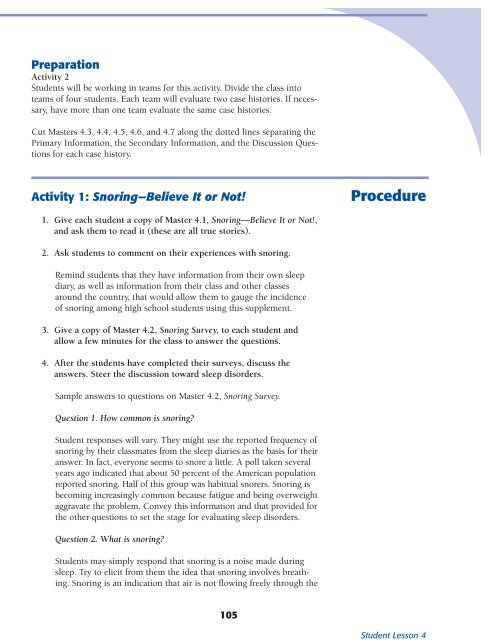Biological - NIH Office of Science Education - National Institutes of ...
Biological - NIH Office of Science Education - National Institutes of ...
Biological - NIH Office of Science Education - National Institutes of ...
You also want an ePaper? Increase the reach of your titles
YUMPU automatically turns print PDFs into web optimized ePapers that Google loves.
Preparation<br />
Activity 2<br />
Students will be working in teams for this activity. Divide the class into<br />
teams <strong>of</strong> four students. Each team will evaluate two case histories. If necessary,<br />
have more than one team evaluate the same case histories.<br />
Cut Masters 4.3, 4.4, 4.5, 4.6, and 4.7 along the dotted lines separating the<br />
Primary Information, the Secondary Information, and the Discussion Questions<br />
for each case history.<br />
Activity 1: Snoring—Believe It or Not!<br />
Procedure<br />
1. Give each student a copy <strong>of</strong> Master 4.1, Snoring—Believe It or Not!,<br />
and ask them to read it (these are all true stories).<br />
2. Ask students to comment on their experiences with snoring.<br />
Remind students that they have information from their own sleep<br />
diary, as well as information from their class and other classes<br />
around the country, that would allow them to gauge the incidence<br />
<strong>of</strong> snoring among high school students using this supplement.<br />
3. Give a copy <strong>of</strong> Master 4.2, Snoring Survey, to each student and<br />
allow a few minutes for the class to answer the questions.<br />
4. After the students have completed their surveys, discuss the<br />
answers. Steer the discussion toward sleep disorders.<br />
Sample answers to questions on Master 4.2, Snoring Survey.<br />
Question 1. How common is snoring?<br />
Student responses will vary. They might use the reported frequency <strong>of</strong><br />
snoring by their classmates from the sleep diaries as the basis for their<br />
answer. In fact, everyone seems to snore a little. A poll taken several<br />
years ago indicated that about 50 percent <strong>of</strong> the American population<br />
reported snoring. Half <strong>of</strong> this group was habitual snorers. Snoring is<br />
becoming increasingly common because fatigue and being overweight<br />
aggravate the problem. Convey this information and that provided for<br />
the other questions to set the stage for evaluating sleep disorders.<br />
Question 2. What is snoring?<br />
Students may simply respond that snoring is a noise made during<br />
sleep. Try to elicit from them the idea that snoring involves breathing.<br />
Snoring is an indication that air is not flowing freely through the<br />
105<br />
Student Lesson 4

















